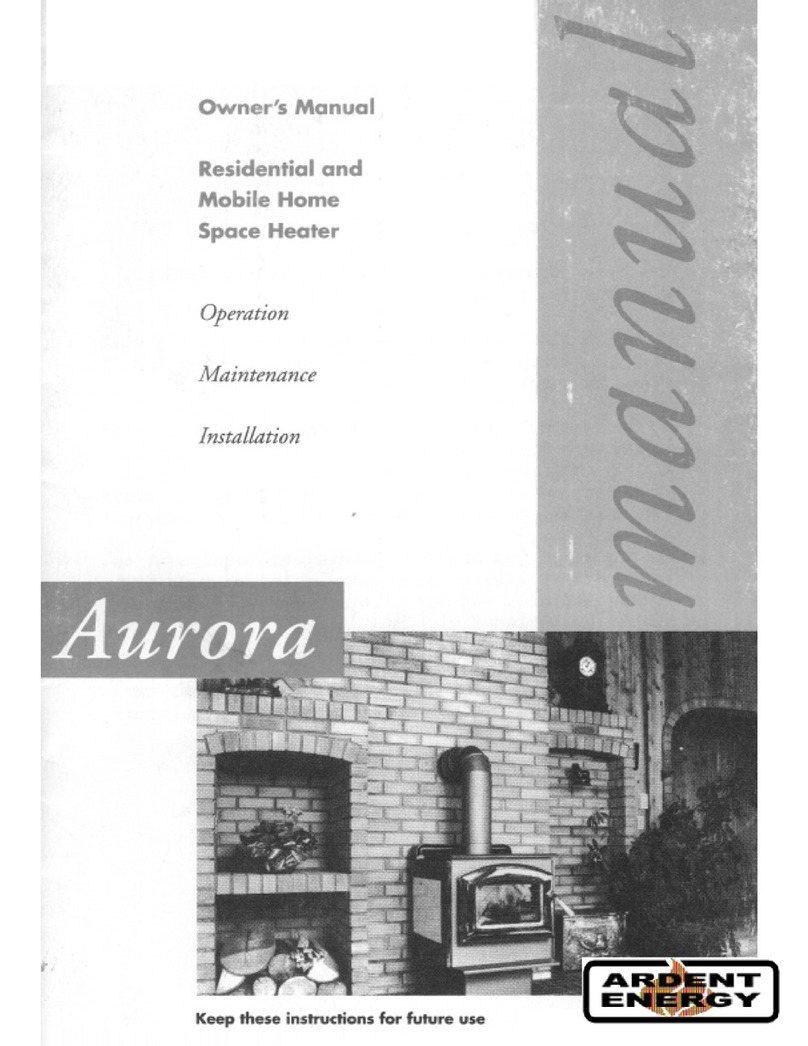
Model HF85R 5
DRAFT CONTROL
Check that it opens and closes freely.
FIREBRICK
Care should be taken when refueling to avoid breakage of brick.
If frozen wood is burned, do not let frozen surface touch brick.
Broken brick must be replaced to prevent overheating of firebox.
Periodically check the door seal for condition and tightness of
door fit. If seal shows signs of a deteriorating condition, improper
fit or signs of leakage, it should be replaced.
PAINT
The midnight brown, high temperature paint is designed to with-
stand temperatures to 6500C (12000F). However, should paint
discoloration happen, the affected areas can be retouched. For
the correct type of paint, contact your dealer. When first using the
unit, the paint may smoke for 1/2 hour to 1 hour. This is normal
and is part of the curing process.
HOT WATER SYSTEM
DRAINING AND CLEANING
Cleaning should not normally be necessary unless water tends to
cause deposits. Should heating efficiency drop off noticeably, the
coil in the heater should be inspected and if necessary, cleaned.
Suggested Procedure for Cleaning Coil (see Fig. 6 on Page 7):
1. Let the unit cool down.
2. Close the valves to the Range Boiler from the coil.
3. Open the drain valve & drain water from the coil.
4. Disconnect the piping & unions.
5. Clean the coil, using a drain cleaning “snake.”
6. Connect piping, close drain and open valves to range boiler.
WHEN YOU HAVE NO WATER
Your heater should not be fired with a dry water coil. If you have
no water for circulation, the coil should be isolated from the sys-
tem and removed, replacing open holes with two 25 mm (1”) di-
ameter standard washers per hole, using a 19 mm x 25 mm (3/4”
X 1”) bolt to hold washers together.
INSTALLATION
LOCATION AND CLEARANCES
MINIMUM CLEARANCE TO COMBUSTIBLE MATERIALS:
INSTALLATION PROCEDURE
1. Do not locate near an exit. Do not connect space heater to
any air distribution duct.
2. Locate heater and floor protection as central as possible
within the home or space to be heated, observing minimum
clearances to combustible materials listed above.
Sidewall (A) 515 mm (20”)
Backwall (B) 305 mm (12”)
Sidewall (D) 700 mm (27½”)
Backwall (E) 395 mm (15½”)
3. To ensure vertical alignment, suspend a plumb bob from
the ceiling over the exact center of the flue of the stove,
and mark a spot on the ceiling to indicate the center of the
chimney.
4. Check that the intended location will not interfere with ceil-
ing joists or rafters before proceeding further.
5. Install chimney according to chimney manufacturer’s in-
structions. Read section on Chimney and see Diagram 2.
Chimney must be a 8” diameter listed chimney suitable for
wood burning appliances. If an existing masonry chimney
is to be used read section under Chimney for specific cau-
tions.
6. Ceiling shield S85 must be installed on ceilings less than
2.4 m (94”) high. Install shield directly over stove and se-
cure to ceiling with screws provided.
7. Use plumb bob to ensure that the heater flue is centered
under the chimney.
8. Install chimney connector. The connector must be at least
24 gauge steel. Insert crimped end of the 8” diameter con-
nector into the heater flue. Install additional connector to
meet chimney.
9. Connect chimney connector to chimney as per chimney
manufacturer’s instructions.
Combustible floor must be protected by non-combustible material
extending beneath the heater and to the front and sides as indi-
cated: G - 460 mm (18”) ; H - l50 mm (6”) ; 1 - 150 mm (6”)
The space beneath the heater must not be obstructed.
Smoke detector must be located a minimum of 4.5 meters (15’)
away from heating unit to avoid accidentally setting off the smoke
detector.
NOTE:Clearances may be reduced only if combustible material
is protected (See CSA Installation Code for Solid Fuel
Burning Appliances and Equipment No B365—M 1991)
Clearances may be reduced by means approved by the regula-
tory authority.
CONNECTION TO CHIMNEY
Chimney suitability is the most important factor that will influence
the performance of your ARDENT ENERGY heater. If you follow
these instructions your heater will perform efficiently. If an exist-
ing chimney does not meet the specifications consult your AR-
DENT ENERGY dealer about remedial action.
Unit must be connected to the chimney using a minimum of el-
bows and horizontal pipe. All horizontal pipe must slope toward
heater and be installed with seam up. Unit flue opening is de-
signed for the connector to go into the opening.
All connections must be such that any condensation in the flue
runs back into the unit and not onto the floor. Ensure connection
pipe is spaced at least 460 mm (18”) from any unprotected com-
bustible material. Do not pass a chimney connector through an
attic or roof space, closet or similar concealed space, or a floor,
ceiling, wall or partition of combustible construction.
FIG. 3




























